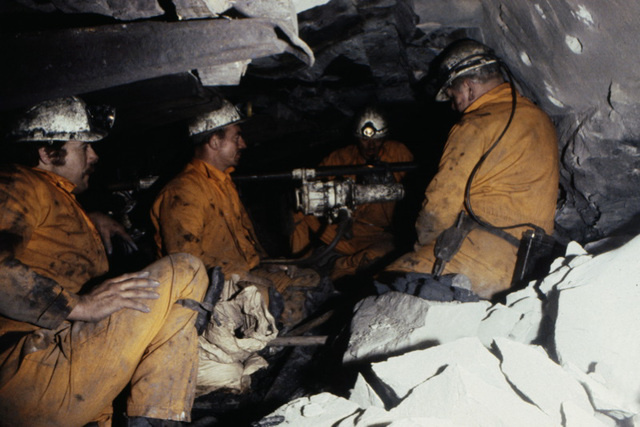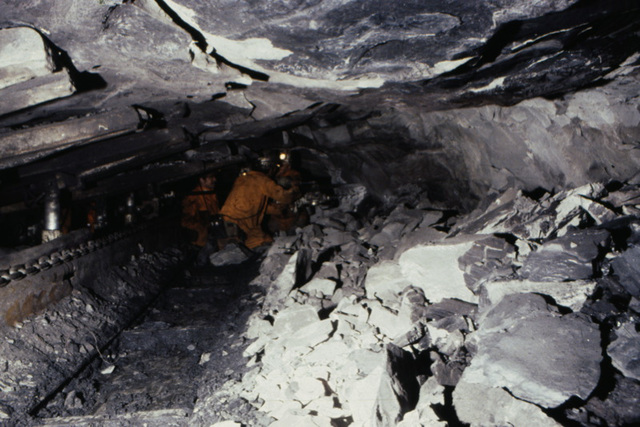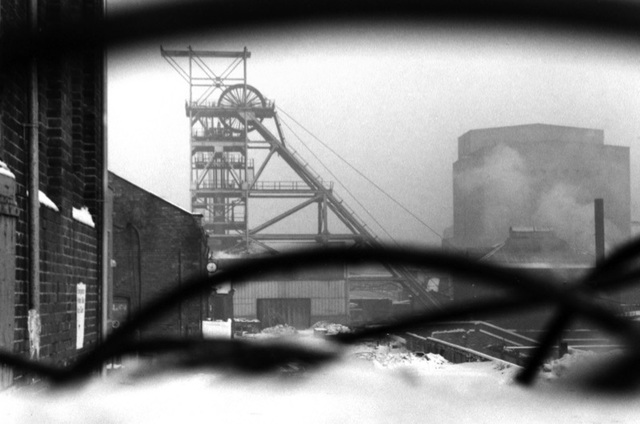
Orgreave Colliery 1976 - 1988
Folder: Mining and quarrying
Orgeave Coke Ovens 1988
Coal from Orgreave Colliery was taken directly into the adjacent British Steel coke ovens to make metallurgical coke for the steel industry. There was also an extensive coal by-products chemical works at the same site.
When the wind was in an unfavourable direction, it blew the fumes from the coke ovens straight over the colliery downcast shaft where the smell was quickly spread all round the mine workings underground.
Orgreave Colliery ceased production in 1981, but coal from nearby Treeton colliery was transported by conveyor to the coke ovens.
01 May 1980
Orgreave S24's washout (3 of 3)
This short sequence of three photographs is a rare chance to see how adverse geological conditions affected a (relatively) modern longwall face. They were taken on 2nd May 1980 at Orgreave Colliery, near Sheffield, South Yorkshire.
Please note that I did not take these photographs. They were taken by my colleague Jim Batty who was the NCB area photographer for South Yorkshire. I have used these on many an occasion to illustrate geology lectures and I am most grateful to him.
Photo 3: A closer view showing the small drilling machine boring the holes for shot firing. You can see previously drilled holes ready to be loaded with explosives.
This sort of situation caused extensive delays to production, and the difficult and, at times, unstable, roof conditions added to the risk of accident and injury on the face, although fortunately as far as I know, there were no serious incidents on this face (a wonder).
This whole washout area was around 20 - 30 metres wide from one side to the other, on a coal face that was about 180 metres wide. Eventually the washout sandstone lifted clear of the coal and production was able to be resumed relatively normally, although there were still roof control problems on this face for much of its life.
It was these sorts of conditions coupled with the fact that there was nowhere else left to work underground that led to the inevitable closure of Orgreave the following year.
01 May 1980
Orgreave S24's washout (2 of 3)
This short sequence of three photographs is a rare chance to see how adverse geological conditions affected a (relatively) modern longwall face. They were taken on 2nd May 1980 at Orgreave Colliery, near Sheffield, South Yorkshire.
Please note that I did not take these photographs. They were taken by my colleague Jim Batty who was the NCB area photographer for South Yorkshire. I have used these on many an occasion to illustrate geology lectures and I am most grateful to him.
Photo 2: A view looking along Orgreave S24's face in the Swallow Wood seam. The coal seam which was on the right has now been replaced by "washout" sandstone (light grey in colour). This is much too hard and strong for the normal coal cutting machine to cut through, and there would in any case have been the risk of hot frictional sparking causing ignition of any methane that might be present.
Instead, the sandstone has to be bored and broken down by firing with permitted explosives. That is what the men in the distance are doing. Previously fired-down sandstone is visible to the right of centre and the whole situation resembles an underground stone quarry rather than a proper longwall coal face.
01 May 1980
Orgreave S24's washout (1 of 3)
This short sequence of three photographs is a rare chance to see how adverse geological conditions affected a (relatively) modern longwall face. They were taken on 2nd May 1980 at Orgreave Colliery, near Sheffield, South Yorkshire.
Please note that I did not take these photographs. They were taken by my colleague Jim Batty who was the NCB area photographer for South Yorkshire. I have used these on many an occasion to illustrate geology lectures and I am most grateful to him.
Photo 1: A view looking along Orgreave S24's face in the Swallow Wood seam. The coal seam is on the right, the banks of hydraulic powered roof supports are on the left. The normal travelling way (a crawl!) is beneath this canopy of supports. In the centre leading away into the distance is the armoured steel conveyor (the 'panzer'). You can also see the sprocket chain that coal cutting machine (not visible here) used to haul itself along the top of the conveyor.
This particular coal face operated in the year before the mine closed, and it was beset with geological difficulties, which were suspected in advance, and that's why this particular patch of coal was one of the very last to be worked.
The main problem was the irregular, undulating sandstone roof. In essence, the coal was worked beneath a complex 'fossil' river channel system, where sand originally deposited by the rivers fills in the channels and eventually gets turned into sandstone. In this photo the sandstone is pale grey and sits fairly evenly on top of the coal. But it is already breaking into large lumps and falling out prematurely. Further on, in photos 2 and 3, the river has cut down more deeply and eroded away the vegetation that was to eventually become coal, causing a 'washout'.
It was part of my job to map these channel features and to try to predict what they would do next. So I spent a lot of time on this particular face. I remember it very well indeed.
Winter scene at Orgreave
View of Orgreave No.1 (downcast) shaft on a winter's day in 1977.
Taken with a Zenit 'E' on Kodacolor film. Changed to B&W in Photoshop.
Dire Warning at Orgreave!
This warning poster was painted on a wooden panel and fixed to the side of the upcast shaft next to the air lock doors. It was therefore visible to all mine workers as they entered the shaft just prior to going underground.
This photo was taken around 1977 and the poster had been there for many years previously. When the colliery closed in 1981 I wanted to salvage it, but by then it had deteriorated too much and could not have been removed without irreparable damage.
Taken with a Zenit 'E' on Kodacolor film
The young Earthwatcher
Me at Orgreave in 1976!
One of the colliery surveyors took this photo just after I'd come out of the pit.
My Grandmother who lived all her life in the south of England could not believe that I worked in a job where I got dirty with coal dust, so this was taken just to show her.
Orgreave Colliery was located on the east side of Sheffield, between Handsworth and Treeton. It was opened in 1851 and closed due to exhaustion in 1981 - 130 years of continuous coal production.
Taken with a Zenit 'E' on Agfa CT-18 transparency film
Jump to top
RSS feed- Latest items - Subscribe to the latest items added to this album
- ipernity © 2007-2024
- Help & Contact
|
Club news
|
About ipernity
|
History |
ipernity Club & Prices |
Guide of good conduct
Donate | Group guidelines | Privacy policy | Terms of use | Statutes | In memoria -
Facebook
Twitter








